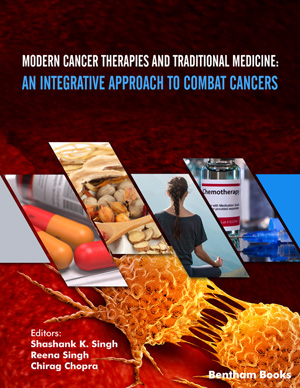
Abstract
Cancer patients are more susceptible to COVID-19; however, the prevalence of COVID-19 in different types of cancer is still inconsistent and inconclusive. Here, we delineate the intricate relationship between breast cancer and COVID-19. Breast cancer and COVID-19 share the involvement of common comorbidities, hormonal signalling pathways, gender differences, rennin- angiotensin system (RAS), angiotensin-converting enzyme-2 (ACE-2), transmembrane protease serine 2 (TMPRSS2) and dipeptidyl peptidase-IV (DPP-IV). We also shed light on the possible effects of therapeutic modalities of COVID-19 on breast cancer outcomes. Briefly, we conclude that breast cancer patients are more susceptible to COVID-19 in comparison with their normal counterparts. Women are more resistant to the occurrence and severity of COVID-19. Increased expressions of ACE2 and TMPRSS2 are correlated with occurrence and severity of COVID-19, but higher expression of ACE2 and lower expression of TMPRSS2 are prognostic markers for overall disease free survival in breast cancer. The ACE2 inhibitors and ibuprofen therapies for COVID-19 treatment may aggravate the clinical condition of breast cancer patients through chemo-resistance and metastasis. Most of the available therapeutic modalities for COVID-19 were also found to exert positive effects on breast cancer outcomes. Besides drugs in clinical trend, TMPRSS2 inhibitors, estrogen supplementation, androgen deprivation and DPP-IV inhibitors may also be used to treat breast cancer patients infected with SARS-CoV-2. However, drug-drug interactions suggest that some of the drugs used for the treatment of COVID-19 may modulate the drug metabolism of anticancer therapies which may lead to adverse drug reaction events.
Keywords: Cytokine storm, ACE-2 receptors, diabetes, breast cancer, TMPRSS2, DPP-IV.
Graphical Abstract
[http://dx.doi.org/10.1002/oby.22947] [PMID: 32610371]
[http://dx.doi.org/10.1002/jmv.26237] [PMID: 32603481]
[http://dx.doi.org/10.1210/endocr/bqaa112] [PMID: 32603424]
[http://dx.doi.org/10.18433/jpps31069] [PMID: 32324533]
[http://dx.doi.org/10.1016/S0140-6736(20)30211-7] [PMID: 32007143]
[http://dx.doi.org/10.1056/NEJMoa2002032] [PMID: 32109013]
[http://dx.doi.org/10.1053/j.seminoncol.2020.06.002] [PMID: 32660890]
[http://dx.doi.org/10.1016/j.cell.2020.02.052] [PMID: 32142651]
[http://dx.doi.org/10.1007/s00592-020-01539-z] [PMID: 32506195]
[http://dx.doi.org/10.3389/fphar.2020.01161] [PMID: 32848769]
[http://dx.doi.org/10.1016/j.ctrv.2018.08.004] [PMID: 30130687]
[http://dx.doi.org/10.1242/jcs.107.10.2931] [PMID: 7876358]
[http://dx.doi.org/10.1159/000024497] [PMID: 10207249]
[http://dx.doi.org/10.1074/jbc.273.37.24207] [PMID: 9727044]
[http://dx.doi.org/10.1074/mcp.M112.017384] [PMID: 22896658]
[http://dx.doi.org/10.1016/j.canlet.2016.04.006] [PMID: 27063099]
[http://dx.doi.org/10.1186/s13046-019-1156-5] [PMID: 31023337]
[http://dx.doi.org/10.3892/ijmm.2020.4646] [PMID: 32705281]
(b) Stang, A. Critical evaluation of the Newcastle-Ottawa scale for the assessment of the quality of nonrandomized studies in meta-analyses. Eur. J. Epidemiol., 2010, 25(9), 603-605.
[http://dx.doi.org/10.1007/s10654-010-9491-z] [PMID: 20652370]
[PMID: 32345594]
[http://dx.doi.org/10.1016/S1470-2045(20)30149-2] [PMID: 32142621]
[http://dx.doi.org/10.1016/S1470-2045(20)30150-9] [PMID: 32142622]
[http://dx.doi.org/10.1016/j.critrevonc.2020.103032] [PMID: 32599375]
[http://dx.doi.org/10.1007/s11033-020-05478-4] [PMID: 32410141]
[http://dx.doi.org/10.7150/ijbs.51234] [PMID: 33061814]
[http://dx.doi.org/10.7150/ijbs.48639] [PMID: 32760213]
[http://dx.doi.org/10.1016/j.breast.2016.07.015] [PMID: 27481651]
[http://dx.doi.org/10.1016/S0192-0561(98)00077-0] [PMID: 10230872]
[http://dx.doi.org/10.1186/s13045-019-0787-5] [PMID: 31492199]
[http://dx.doi.org/10.1002/(SICI)1096-9896(199909)189:1<12::AID-PATH431>3.0.CO;2-F] [PMID: 10451482]
[http://dx.doi.org/10.1093/jnci/92.9.709] [PMID: 10793107]
[http://dx.doi.org/10.1126/science.1152586] [PMID: 18202256]
[http://dx.doi.org/10.1016/j.diabres.2020.108125] [PMID: 32224164]
[http://dx.doi.org/10.1016/j.diabres.2020.108216] [PMID: 32416120]
[http://dx.doi.org/10.1023/A:1006757525190] [PMID: 10845560]
[http://dx.doi.org/10.1016/j.clbc.2016.11.002] [PMID: 27986440]
[http://dx.doi.org/10.3892/mmr.2018.8475] [PMID: 29393459]
[http://dx.doi.org/10.1210/en.2017-00461] [PMID: 29045658]
[http://dx.doi.org/10.1530/ERC-11-0335] [PMID: 22180497]
[http://dx.doi.org/10.1038/s41569-019-0244-8] [PMID: 31427727]
[http://dx.doi.org/10.1016/0303-7207(92)90101-B] [PMID: 1338730]
[PMID: 8246129]
[http://dx.doi.org/10.1113/jphysiol.2014.276584] [PMID: 24951624]
[http://dx.doi.org/10.1073/pnas.93.18.9960] [PMID: 8790439]
[http://dx.doi.org/10.1097/00005344-199704000-00004] [PMID: 9156353]
[http://dx.doi.org/10.1161/01.RES.73.3.413] [PMID: 8348686]
[http://dx.doi.org/10.1161/01.CIR.89.5.2273] [PMID: 8181153]
[http://dx.doi.org/10.1046/j.1523-1755.2002.00365.x] [PMID: 12028439]
[http://dx.doi.org/10.1172/JCI116043] [PMID: 1331171]
[http://dx.doi.org/10.3389/fmed.2018.00365] [PMID: 30729109]
[http://dx.doi.org/10.3389/fphys.2013.00105] [PMID: 23717285]
[http://dx.doi.org/10.1046/j.1523-1755.1999.00377.x] [PMID: 10200991]
[PMID: 8160866]
[http://dx.doi.org/10.1016/S0167-0115(98)00039-1] [PMID: 9712180]
[http://dx.doi.org/10.1016/S0196-9781(97)00291-X] [PMID: 9493859]
[http://dx.doi.org/10.1080/13880209.2016.1257642] [PMID: 27927051]
[http://dx.doi.org/10.1016/j.peptides.2016.03.017] [PMID: 27038740]
[http://dx.doi.org/10.1161/HYPERTENSIONAHA.107.103242] [PMID: 18158338]
[http://dx.doi.org/10.1097/HJH.0000000000000094] [PMID: 24463937]
[http://dx.doi.org/10.1016/0006-8993(94)91171-1] [PMID: 7882013]
[http://dx.doi.org/10.1161/01.HYP.29.1.394] [PMID: 9039133]
[http://dx.doi.org/10.1111/j.1476-5381.1994.tb14014.x]
[http://dx.doi.org/10.1097/FJC.0b013e3182588b32] [PMID: 22526299]
[http://dx.doi.org/10.1152/ajpheart.00984.2006] [PMID: 17085537]
[http://dx.doi.org/10.1152/ajpcell.00153.2017] [PMID: 29443552]
[http://dx.doi.org/10.1161/CIRCRESAHA.113.301077] [PMID: 23446738]
[http://dx.doi.org/10.1016/j.peptides.2017.09.005] [PMID: 28889964]
[http://dx.doi.org/10.1016/j.mehy.2020.110091] [PMID: 32663742]
[http://dx.doi.org/10.26402/jpp.2019.4.02] [PMID: 31642813]
[http://dx.doi.org/10.1016/j.cjca.2020.03.005] [PMID: 32389345]
[http://dx.doi.org/10.21037/atm.2020.04.28] [PMID: 32411754]
[http://dx.doi.org/10.1128/AAC.00754-20] [PMID: 32312781]
[http://dx.doi.org/10.1007/s10549-011-1505-3] [PMID: 21479924]
[http://dx.doi.org/10.1016/j.critrevonc.2020.102982] [PMID: 32460133]
[PMID: 32395418]
[http://dx.doi.org/10.1097/CAD.0b013e32832f4e50] [PMID: 19584707]
[http://dx.doi.org/10.1007/s00280-016-3197-1] [PMID: 27889812]
[http://dx.doi.org/10.1016/j.bcp.2004.05.003] [PMID: 15450938]
[http://dx.doi.org/10.3346/jkms.2020.35.e79] [PMID: 32056407]
[http://dx.doi.org/10.1124/dmd.115.066795] [PMID: 26700956]
[http://dx.doi.org/10.21873/anticanres.13793] [PMID: 31704813]
[http://dx.doi.org/10.1021/jp102619w] [PMID: 20527735]
[http://dx.doi.org/10.5582/ddt.2020.01012] [PMID: 32147628]
[http://dx.doi.org/10.1016/j.jinf.2020.03.002] [PMID: 32171872]
[http://dx.doi.org/10.2183/pjab.93.027] [PMID: 28769016]
[http://dx.doi.org/10.26633/RPSP.2020.40] [PMID: 32256547]
[http://dx.doi.org/10.2147/DDDT.S242514] [PMID: 32546966]
[PMID: 25525387]
[http://dx.doi.org/10.1016/j.ijantimicag.2020.105949] [PMID: 32205204]
[http://dx.doi.org/10.1016/j.idcr.2020.e00864] [PMID: 32566483]
[http://dx.doi.org/10.18632/aging.101905] [PMID: 31002656]
[http://dx.doi.org/10.4110/in.2013.13.2.70] [PMID: 23700397]
[http://dx.doi.org/10.3390/antiox7030041] [PMID: 29534432]
[http://dx.doi.org/10.1038/s41598-018-23714-7] [PMID: 29593282]
[http://dx.doi.org/10.2174/1871520619666190930130732] [PMID: 31566138]
[http://dx.doi.org/10.2147/OTT.S222702] [PMID: 31571901]
[http://dx.doi.org/10.3390/nu11122997] [PMID: 31817810]
[http://dx.doi.org/10.1016/S0140-6736(20)30361-5] [PMID: 32122468]
[http://dx.doi.org/10.1007/978-1-4939-2895-8_14] [PMID: 26216001]
[http://dx.doi.org/10.1016/j.jtcvs.2009.04.063] [PMID: 19931670]
[http://dx.doi.org/10.1128/JVI.79.3.1966-1969.2005] [PMID: 15650225]
[http://dx.doi.org/10.1002/(SICI)1097-0215(20000401)86:1<30::AID-IJC5>3.0.CO;2-I] [PMID: 10728591]
[http://dx.doi.org/10.1038/sj.gt.3301609] [PMID: 11896465]
[http://dx.doi.org/10.1016/S1078-1439(02)00208-9] [PMID: 12856639]
[http://dx.doi.org/10.1016/j.redox.2015.07.002] [PMID: 26164533]
[http://dx.doi.org/10.1128/AAC.03659-14] [PMID: 25487801]
[http://dx.doi.org/10.1007/s00280-005-0173-6] [PMID: 16404634]
[http://dx.doi.org/10.1007/s10549-015-3292-8] [PMID: 25687356]
[http://dx.doi.org/10.1186/s12967-020-02339-3] [PMID: 32290839]
[http://dx.doi.org/10.1002/mc.23234] [PMID: 32537818]
[http://dx.doi.org/10.1016/j.biopha.2018.09.177] [PMID: 30372844]
[http://dx.doi.org/10.1159/000452315] [PMID: 27920627]
[http://dx.doi.org/10.1111/j.1365-2567.2006.02539.x] [PMID: 17425601]
[http://dx.doi.org/10.1371/journal.pone.0013251] [PMID: 20967263]
[http://dx.doi.org/10.1016/S2213-2600(20)30116-8] [PMID: 32171062]
[PMID: 19079765]
[PMID: 17302372]
[http://dx.doi.org/10.1593/neo.06673] [PMID: 17401462]
[http://dx.doi.org/10.2147/IJN.S141229] [PMID: 28883726]
[PMID: 27569074]
[http://dx.doi.org/10.1016/j.jacc.2013.08.726] [PMID: 24036026]
[http://dx.doi.org/10.1016/j.semarthrit.2015.06.013] [PMID: 26228647]
[http://dx.doi.org/10.1128/AAC.48.7.2693-2696.2004] [PMID: 15215127]
[http://dx.doi.org/10.1038/s41467-019-13659-4] [PMID: 31852899]
[http://dx.doi.org/10.1177/1087057110390360] [PMID: 21297106]
[http://dx.doi.org/10.1016/j.antiviral.2020.104787] [PMID: 32251768]
[http://dx.doi.org/10.1371/journal.pone.0085887] [PMID: 24416452]
[http://dx.doi.org/10.1371/journal.pone.0074538] [PMID: 24058587]
[http://dx.doi.org/10.1038/s41388-018-0340-y] [PMID: 29855616]
[http://dx.doi.org/10.1038/s41598-019-47707-2] [PMID: 31383893]
[http://dx.doi.org/10.1038/srep16222] [PMID: 26552848]
[http://dx.doi.org/10.1158/0008-5472.CAN-15-2887] [PMID: 27302166]
[PMID: 29257278]
[http://dx.doi.org/10.1016/j.antiviral.2014.11.010] [PMID: 25451075]
[http://dx.doi.org/10.1016/j.jiph.2016.04.001] [PMID: 27095301]
[http://dx.doi.org/10.1158/1535-7163.MCT-12-1243] [PMID: 23825064]
[http://dx.doi.org/10.1016/j.mrfmmm.2014.05.005] [PMID: 25847384]
[http://dx.doi.org/10.1111/jth.14768] [PMID: 32073213]
[http://dx.doi.org/10.1038/sj.bjc.6603928] [PMID: 17726466]
[http://dx.doi.org/10.1158/2159-8290.CD-20-0451] [PMID: 32276929]
[http://dx.doi.org/10.3390/ijms140714659] [PMID: 23857060]
[http://dx.doi.org/10.1515/hsz-2016-0131] [PMID: 27078673]
[http://dx.doi.org/10.1016/j.ctrv.2020.102063] [PMID: 32623296]
[http://dx.doi.org/10.1016/j.eclinm.2020.100523] [PMID: 32984788]
[http://dx.doi.org/10.1016/S2352-3026(20)30123-X] [PMID: 32339482]
[http://dx.doi.org/10.1007/s11523-020-00721-1] [PMID: 32445083]
[http://dx.doi.org/10.1016/j.eclinm.2020.100503] [PMID: 32989430]
[http://dx.doi.org/10.1007/s10654-020-00631-6] [PMID: 32306149]
[http://dx.doi.org/10.1016/j.ejso.2020.06.025] [PMID: 32571635]
[http://dx.doi.org/10.1016/j.ejso.2020.04.026] [PMID: 32359919]
[http://dx.doi.org/10.1016/j.breast.2020.04.006] [PMID: 32334323]
[http://dx.doi.org/10.1016/j.ijsu.2020.05.002] [PMID: 32413502]
[http://dx.doi.org/10.1007/s10549-020-05644-z] [PMID: 32333293]
[http://dx.doi.org/10.1016/j.clon.2020.03.006] [PMID: 32241520]
[http://dx.doi.org/10.1016/j.adro.2020.03.013] [PMID: 32292842]
[http://dx.doi.org/10.1200/OP.20.00364] [PMID: 32603252]
[http://dx.doi.org/10.1007/s10549-020-05877-y] [PMID: 32803637]
[http://dx.doi.org/10.1200/OP.20.00297] [PMID: 32574131]
[http://dx.doi.org/10.1007/s10549-020-05828-7] [PMID: 32772225]
[PMID: 32610364]
[http://dx.doi.org/10.1016/j.biochi.2020.07.001] [PMID: 32649962]
[http://dx.doi.org/10.1530/ERC-12-0242] [PMID: 23035011]
[http://dx.doi.org/10.1038/bjc.2012.414] [PMID: 22996614]
[http://dx.doi.org/10.1002/ijc.22717] [PMID: 17397032]
[http://dx.doi.org/10.1097/MD.0000000000005602] [PMID: 27930583]
[http://dx.doi.org/10.1210/en.2018-00574] [PMID: 30215698]
[http://dx.doi.org/10.1007/s12253-011-9466-8] [PMID: 21984197]
[http://dx.doi.org/10.1371/journal.pone.0170084] [PMID: 28076434]
[http://dx.doi.org/10.2337/db10-0334] [PMID: 20427699]
[http://dx.doi.org/10.1007/s11892-012-0356-6] [PMID: 23271574]
[http://dx.doi.org/10.1007/s00125-010-1815-8] [PMID: 20549181]
[http://dx.doi.org/10.1091/mbc.e14-11-1550] [PMID: 26371080]
[http://dx.doi.org/10.1155/2011/708183] [PMID: 21773024]
[http://dx.doi.org/10.1155/2012/481840] [PMID: 22474423]
[http://dx.doi.org/10.1016/j.ctrv.2013.03.009] [PMID: 23643661]
[http://dx.doi.org/10.1016/j.pharmthera.2017.02.037] [PMID: 28216025]
[PMID: 17822320]
[http://dx.doi.org/10.1186/bcr2886] [PMID: 21867572]
[http://dx.doi.org/10.1016/j.devcel.2009.06.016] [PMID: 19619488]
[http://dx.doi.org/10.1155/2015/183928] [PMID: 26171112]
[http://dx.doi.org/10.1016/j.bbamcr.2014.01.012] [PMID: 24440276]
[http://dx.doi.org/10.1016/j.semcancer.2015.04.007] [PMID: 25953433]
[http://dx.doi.org/10.1002/ijc.10628] [PMID: 12209955]
[http://dx.doi.org/10.1016/S1470-2045(05)01736-5] [PMID: 15683819]
[http://dx.doi.org/10.1016/j.jaccas.2020.04.027] [PMID: 32373791]
[http://dx.doi.org/10.1001/jamanetworkopen.2020.5619] [PMID: 32275319]
[PMID: 10718692]
[http://dx.doi.org/10.1001/jama.2020.2648] [PMID: 32091533]
[http://dx.doi.org/10.2147/IJGM.S67061] [PMID: 25187734]
[http://dx.doi.org/10.1186/2042-6410-2-8] [PMID: 21806829]
[http://dx.doi.org/10.1038/nri.2016.90] [PMID: 27546235]
[http://dx.doi.org/10.1186/s40246-018-0185-z] [PMID: 30621780]
[http://dx.doi.org/10.1093/cvr/cvaa078] [PMID: 32227090]
[http://dx.doi.org/10.1042/CS20200163] [PMID: 32167153]
[http://dx.doi.org/10.1016/j.cell.2020.04.035] [PMID: 32413319]
[PMID: 11245484]
[http://dx.doi.org/10.1002/jcph.1641] [PMID: 32437018]
[http://dx.doi.org/10.4049/jimmunol.1601896] [PMID: 28373583]
[http://dx.doi.org/10.1093/aje/kwh056] [PMID: 14742282]
[http://dx.doi.org/10.1111/jocd.13443] [PMID: 32301221]
[http://dx.doi.org/10.1016/j.jaad.2020.05.079] [PMID: 32446821]
[http://dx.doi.org/10.1016/j.annonc.2020.04.479] [PMID: 32387456]
[http://dx.doi.org/10.3389/fimmu.2018.01931] [PMID: 30210492]
[http://dx.doi.org/10.1002/bies.201200099] [PMID: 23012250]
[http://dx.doi.org/10.4049/jimmunol.1601166] [PMID: 28223406]
[http://dx.doi.org/10.1186/bcr424] [PMID: 11879565]
[PMID: 9626131]
[http://dx.doi.org/10.1016/S0895-4356(98)00035-3] [PMID: 9674665]
[http://dx.doi.org/10.1023/A:1009575518338] [PMID: 10791773]
[PMID: 15701879]
[http://dx.doi.org/10.1146/annurev-med-070909-182917] [PMID: 20887199]
[http://dx.doi.org/10.1159/000354253] [PMID: 24415978]
[PMID: 27293993]
[http://dx.doi.org/10.1038/sj.onc.1208807] [PMID: 16007178]
[http://dx.doi.org/10.1038/bjc.1988.44] [PMID: 3358913]
[http://dx.doi.org/10.1056/NEJM199506153322401] [PMID: 7753136]
[http://dx.doi.org/10.1093/carcin/17.11.2279] [PMID: 8968038]
[http://dx.doi.org/10.1093/jnci/88.5.291] [PMID: 8614008]
[http://dx.doi.org/10.1016/S0378-5122(01)00213-4] [PMID: 11514109]
[http://dx.doi.org/10.1097/00001703-200402000-00013] [PMID: 15128011]
[PMID: 10696569]

























